- Evidence shows that housing has a major effect on health and that
stable housing can significantly improve health outcomes for chronically
homeless individuals.
- Programs around the country, including in Boston and New York City,
use a Vulnerability Index to assess and prioritize the housing and healthcare
needs of homeless individuals.
- The Chicago Housing for Health Partnership has tested an approach
that combines housing with intensive case management services; this
approach has yielded greater housing stability and fewer hospital visits
for chronically homeless patients.
Experiencing homelessness exacerbates
health problems and the ability
to access appropriate care. Residential
instability and insecurity, including
doubling up and overcrowding, creates
substantial risks to child health, development,
and educational outcomes.1
Housing instability and living in lower
socioeconomic neighborhoods can
lead to significant stress, mental health
problems, obesity, and diabetes.2 A
growing body of evidence demonstrates
the positive impact of stable housing on
such outcomes. In response to this increasingly
clear and compelling picture,
the HUD Strategic Plan for fiscal years
2010–2015 included a goal to “utilize
housing as a platform for improving
quality of life.” Recent research provides
particularly strong evidence supporting
the role of housing in improving
outcomes for chronically homeless
individuals. This article will highlight
the evidence by describing three communitywide
approaches to addressing
chronic homelessness in Boston, New
York City, and Chicago.
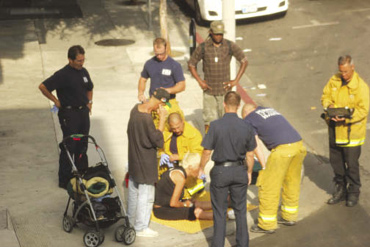
Reliance on emergency health care for meeting needs of homeless persons is less effective and more expensive than
housing and individualized support services. © Louis “Kengi” Carr – Getty Images
Although definitions vary, chronically
homeless individuals generally have
lengthy histories of homelessness and
struggle with disabilities and disabling
health conditions.3 This population
experiences high rates of serious
mental illness, substance abuse, and
chronic physical illness, with these
conditions often co-occurring.
The mortality rate for chronically
homeless persons is four to nine
times higher than that for the general
population.4
Homelessness impedes access to health
care and the ability to stay healthy,
such as eating well, getting enough
sleep, taking medication regularly, and
caring for injuries. Socially isolated,
many chronically homeless individuals
receive little or no health care and no
continuity of care. Addressing the intensive
health needs of these vulnerable
individuals with emergency, acute care
interventions are extremely costly and
have not proven to be effective. Without
intervention, chronically homeless individuals
who struggle with serious primary
and behavioral health issues continue
to cycle intermittently from the street
through shelters, emergency rooms, and
prisons — and then back
to the street again.
As intractable as the problem seems,
evidence suggests that the right tools
and approaches can reduce chronic
homelessness. In many cases, permanent
supportive housing programs — in
particular, those that follow the “housing
first” model — are successful in moving
chronically homeless individuals off
the streets and into stable housing.
Perhaps equally compelling to communities
battling chronic homelessness is
the cost effectiveness of the strategy.
Cycling chronically homeless individuals
through expensive public systems carries
a steep economic cost. Providing shelter
or supportive housing costs less and results
in savings, compared with other interventions.
For example, the typical daily per
capita charge for shelter ($28) and affordable
supportive housing ($31) are much
less than the cost of hospital inpatient treatment ($1,940), an emergency room visit ($905), a psychiatric hospital intervention ($604), or detoxification ($256).5
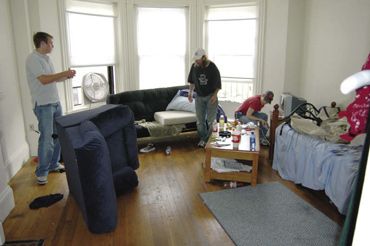
Jill Roncarati and Jason Sousa of BHCHP help Peter Pettibone, formerly homeless, move in to his new apartment. Boston Health Care for the Homeless Program
Around the country, practitioners and researchers from the housing and healthcare communities are discovering and applying evidence-based interventions toward ending chronic homelessness. In Boston, a healthcare organization learns directly about the needs of chronically homeless patients from the patients themselves — and puts those lessons into practice. These lessons have proven relevant in New York City and beyond. In Chicago, a coalition of homeless service providers used their collective experience and resources to design and empirically test an intervention that contributed to understanding what works to improve the health and well-being of medically vulnerable and chronically homeless persons, while also improving resource allocation.
Physician Assistant Jill Roncarati, a member of the Boston Health Care for the Homeless Program’s Street Team, is intimately familiar with the living conditions and needs of chronically homeless individuals. “My patients,” Roncarati says, “are people who live on the streets, on park benches, under bridges, and in back alleyways.” Health problems are caused and exacerbated by homelessness, which is why Roncarati and her colleagues not only take health care to their patients, but also are committed to helping them become housed. “We assist them with the difficult transition from the streets to a home, continuing to provide health care and mental health support as they contend with the challenges of living independently,” she says.
The Boston Health Care for the Homeless Program (BHCHP) combines medical care in the shelters and on the street with care provided by teaching hospitals and neighborhood health centers. Its mission is to make the highest-quality health care accessible to Boston’s homeless population.6 The program’s clinical services began nearly 30 years ago with a 3-year Health Care for the Homeless demonstration project grant from the Robert Wood Johnson Foundation and the Pew Charitable Trusts. Dr. James O’Connell, president and founder of BHCHP, recounts that during the initial grant period, the group operated 3 hospital clinics and 14 clinics in adult and family shelters; established the first medical respite program in the country, with 25 beds that provided temporary care and time to heal; initiated street services with a physician and an overnight van for taking around-the-clock health services to those sleeping on the streets; and created a multidisciplinary, multicultural HIV team to offer primary and specialty care to the city’s homeless population. After Congress passed the Stewart B. McKinney Homeless Assistance Act in 1987, BHCHP became a federally qualified health center funded by the Health
Resources and Services Administration’s Bureau of Primary Health Care. Over time, the program has evolved
as a public healthcare model that focuses on prevention, treatment, and continuity of care.7
Today, BHCHP annually treats more than 11,000 homeless individuals who use homeless shelters, eat at soup kitchens, sleep on the streets, or work on the backstretch and sleep in the stables and barns of Boston’s Suffolk Downs racetrack. Close collaboration among doctors, physician assistants, nurses, nurse practitioners, and case managers offers primary care that enables a patient to move more easily from the street to a clinic, hospital, or respite care, and ultimately to housing. Specialty care, including dental, mental health, and psychiatric services, are also integrated with the primary care service model.
Principal points of contact with their patients are made on the street and at homeless shelters by teams of clinicians. Nearly every homeless shelter in the city hosts a clinic, as do three of the hospitals. Clinicians are able to access patients’ medical records electronically.8 BHCHP also runs a 104-bed care facility that provides respite and recuperative services for patients who need to heal, receive treatment for diseases such as pneumonia and cancer, be monitored for conditions like blood sugar levels or trench foot,
or even prepare for a colonoscopy.
Roncarati says this option for respite care is a critical piece of providing health care for homeless, chronically
ill individuals: “I couldn’t treat my
patients successfully without it.”
HomeStart, a nonprofit that links homeless people to housing opportunities and resources, is one of several housing agencies to which BHCHP refers patients. Because all of BHCHP’s patients are both chronically homeless and chronically ill, those who have been homeless for the longest time are given priority for referrals. Through its Housing First initiative, HomeStart makes housing vouchers available to these referrals and provides stabilization services. A BHCHP team member accompanies and introduces a patient to HomeStart and assists with applying for services, securing income, and ensuring transportation access for patients. HomeStart helps patients equip their new home, shop, and otherwise get stabilized. BHCHP follows up with house calls to ensure continuity of health care and preserve patient-doctor relationships. With more patients being housed, Roncarati notes a change in the flow of care: “It cuts down on the number of people we can see. The team has to prioritize to determine who needs the next visit. Our staffers talk a lot, stay in touch by phone with patients, and try to stay flexible to get medical and health care to those needing it the most.”
The health care program’s work and experience with chronically homeless persons also generate research that has helped shape its own approach and inform other service providers. Motivated by high morbidity and mortality rates among the homeless during the 1990s, medical researchers affiliated with the program began to study the medical records of BHCHP clients to identify factors other than homelessness that were associated with death.9 The research of Stephen Hwang, James O’Connell, and their medical colleagues established that chronic health conditions put homeless persons at significantly heightened risk for dying on the street.10 Their studies showed that being chronically homeless for six months or more and having one or more of the following markers signaled a high chance of premature death without housing and adequate support:
-
Hospitalization, emergency room visits, or admissions to respite care in the past year;
- aged 60 or older;
- cirrhosis, end-stage liver disease, or renal failure;
- history of frostbite, immersion foot, or hypothermia;
- HIV-positive or AIDS; and
- Tri-morbidity, or co-occurring psychiatric, substance abuse, and chronic medical conditions.11
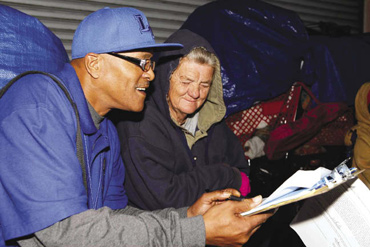
Personal connections forged with people who need stable housing help change perceptions about homelessness. J. B. Rutagarama
These markers formed the basis of what later became known as the Vulnerability Index, a tool used to assess and prioritize the healthcare and housing needs of chronically homeless persons. With these health conditions, BHCHP’s medical researchers learned that even aggressive clinical intervention and 24 hours a day, 7 days a week followup with a chronically homeless cohort could not prevent untimely deaths. Their findings indicated the need for safe places to heal, which respite care and stable housing with intensive support services can provide. Such housing led to lower readmission rates and fewer deaths. For example, individuals who were discharged from a hospital to a homeless respite program were 50 percent less likely to be readmitted within
90 days compared with individuals who were discharged to the shelter system.12,13
“Clearly,” O’Connell concludes, “Housing as an intervention, has
been nothing less than life-saving for people on the street.” Once vulnerable
individuals move into stable housing, they have the basis for improving
their health; at this stage supportive services become particularly crucial. “Although housing is absolutely
necessary, it’s not always sufficient,” states O’Connell, explaining that
skills necessary for living on the
street, which are often finely tuned,
do not necessarily transfer to a stable housing situation. Patients with
multiple and chronic health needs often find navigating a complex
and fragmented healthcare system overwhelming, making wraparound supportive services an essential
component of linking health care
and housing.
In the 1990s, while BHCHP was working out effective strategies in Boston, a nonprofit organization in New York City called Common Ground discovered that the same homeless individuals they were helping to house frequently experienced health crises and hospitalizations. It became apparent to Rosanne Haggerty, then Common Ground’s director, that the healthcare and homeless assistance systems were separately assisting many of the same homeless individuals and not making much progress in either area. It seemed evident that the two systems needed to coordinate their services. Haggerty explains, “We were trying to figure out how to put together an objective and appropriate triage that focused on resources, filled gaps in service, and dealt directly with the serious health issues,” when her team found the answer in the research of James O’Connell and his colleagues from the BHCHP. The markers the Boston researchers had identified for determining those most in need of both health care and stable, supportive housing — now coined the Vulnerability Index by Common Ground — “is so intuitively logical,” says Haggerty.
Common Ground applied the Vulnerability Index in an initiative to reduce chronic street homelessness in Times Square and surrounding blocks. Using the index to assess and prioritize the need for housing and services, the Street to Home initiative not only took medical, psychiatric, and housing placement services to homeless individuals on the street, but also made housing placements directly, bypassing traditional city shelter intake.14 Common Ground’s surveys found that persons experiencing homelessness were averse not to housing, but rather to shelters. “Shelters were, in their minds, associated with broken promises and a number of barriers to housing, like admission criteria that appeared to screen out those most in need of services with requirements such as six months of sobriety and having original copies of government identification documents that were difficult to access. The barriers were profound — impossible for overwhelmed, bereft persons in compromised states of health to deal with,” reports Haggerty.
Common Ground helped people gain access to permanent housing with the right supportive services to fit their needs. As a result, more than 90 percent of those placed in permanent housing remained housed after 12 months. Between 2005 and 2007, homelessness in Times Square declined by 87 percent and by 43 percent in the targeted surrounding 230 blocks. “The very powerful message was that systems needed to change, to eliminate the barriers that homeless individuals were experiencing,” Haggerty points out.
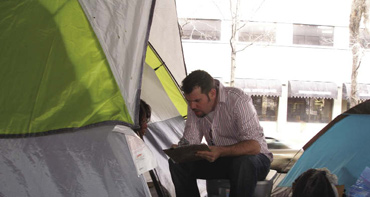
A homeless woman is interviewed by a 100,000 Homes Campaign volunteer. Becky Kanis
A new organization headed by Haggerty, Community Solutions, is taking this systems-change strategy and the Vulnerability Index to the national level with the 100,000 Homes Campaign. The campaign’s goal is to engage communities nationwide in the cause of permanently housing the nation’s most vulnerable and long-term homeless individuals by July 2014. The 100,000 Homes Campaign started in 2008 with a few pilot communities whose successes and best practices were built into a model that could be used (or replicated) by other communities wishing to end homelessness in their community. As of May 2012, 124 participating communities had housed 13,928 chronically homeless people and raised $174,000 for move-in kits featuring basic items, such as eating and cooking utensils, needed
to begin housekeeping.15
Becky Kanis, Community Solutions’ director of innovations and the 100,000 Homes Campaign, reports that the organization has learned significant lessons as the campaign has matured. One of the insights gained during the campaign’s first 18 months is the importance of building a strong local team that will drive sustainable changes in housing systems. The communities that are finding success in the campaign have engaged an array of stakeholders united around a shared goal of reducing chronic homelessness in a particular geographic area.16 Community Solutions has also learned that using the Vulnerability Index changes perceptions about homelessness. When local volunteers survey homeless individuals in the early morning hours to learn their names, take their photographs, and identify their health problems, there is a secondary benefit beyond assessing the need for services. The personal connections forged with people who are ill and need a place to live motivate volunteers to make a difference on behalf of these vulnerable individuals. Haggerty
observes that this personal connection is essential to the campaign because “with [this] change in perceptions, changes in political will and systems tend to follow.”
Kanis also notes that localities have eliminated numerous administrative and bureaucratic barriers to improve or speed up access to housing assistance and services for chronically homeless and vulnerable people. When Kanis helps a local campaign map out and analyze an existing housing system, she often finds practices and beliefs that are pervasive but no longer necessary. Local campaigns are advised that lining up the supply of housing and getting people into housing with supportive services as rapidly as possible means negotiating for housing resources en masse and eliminating all but the most essential
elements of the housing application.17 Some local campaigns have made significant progress in shaving days off the time it takes to house people, such as in Washington DC, where housing placements are achieved in an average of 30 days, compared with 6 to 9 months elsewhere. Eight communities are surpassing the campaign’s benchmark of housing 2.5 percent of their documented vulnerable chronically homeless population each month, whereas others have rates as low as 0.1 percent, Kanis reports.
Once vulnerable individuals move into stable housing, they have a platform for improving their health. The campaign recognizes, however, that until housing and healthcare systems are better integrated, formerly homeless persons will require a lot of assistance to navigate them. Catherine Craig, director of health integration at Community Solutions, helps localities build community partnerships that can bridge healthcare and housing services. This is possible, says Craig, with care coordination built around improving a vulnerable individual’s health. Craig explains that multiple health needs “are not in and of themselves complex challenges; the complexity arises when the tasks of making connections among multiple care providers and linking each intervention to the individual’s overall care plan fall in the lap of the individual. Without effective partnering or support, the challenge of navigating multiple care systems is really daunting.”18
:

Stable housing can enable chronic homeless individuals to stay off the street and improve their health.
In the late 1990s, at the same time that Common Ground was finding that coordinated intervention from the housing and healthcare systems was an effective strategy to reduce chronic homelessness, homeless service providers in Chicago were seeing positive results from a similar approach of linking permanent housing to services. At the time, Arturo Bendixen was the executive director of Interfaith House, a nonprofit that offers residential support and health services to homeless adults with chronic illnesses. Bendixen recalls that “the chronic homeless who went to permanent housing didn’t return to our program still homeless. We saw people stabilize and come back to say ‘thank you.’”
This type of experiential feedback prompted a group of 15 healthcare, respite, and housing providers who served persons experiencing homelessness to come together informally as the Chicago Housing for Health Partnership (CHHP). In 2002, they developed a service delivery model and secured funds to test how well linking health care with housing could address the needs of homeless persons with chronic medical conditions. The model was derived from the collective knowledge and experiences of coalition members who served the homeless population in Chicago. Bendixen, now vice president for Housing Partnerships at the AIDS Foundation of Chicago, notes: “Many of these providers had witnessed the role that stable housing could play in enabling chronic homeless individuals to stay off the street and to improve their situations. The partners shared a client-centered orientation and a belief that when homeless individuals with chronic medical conditions are able to focus energy on healing and maintaining their health, rather than straining to find a place to sleep each night, their health is likely to improve.”19
The coalition carried out a six-month pilot study and subsequent research demonstration project from 2003 to 2007. The demonstration project, funded locally with major contributions from private foundations, was led by the AIDS Foundation of Chicago with Bendixen coordinating the project. Bendixen describes the CHHP model as one characterized by multiagency collaboration and the integration of health, shelter, and housing systems; integrated services that moved ill and homeless persons directly from hospital settings to housing; and intensive case management and “wraparound” supportive services.
:
The coalition partner organizations that designed the model also carried out the demonstration project. The partners funneled funds and client referrals into a centralized process, and then redistributed them to participating agencies for housing and support services. A Systems Integration Team (SIT) consisted of case managers from hospital care, interim housing services, and permanent housing providers. The SIT and CHHP coordinator reviewed client service needs weekly, maintained continuous contact, and kept common records. Caseloads were kept small at a 10:1 ratio, and social workers had direct access to available housing, thereby facilitating an individualized approach to providing housing and services.
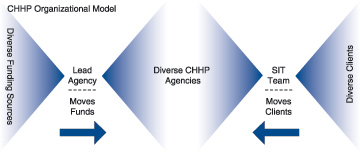
Christine George, Anne Figert, Jennifer Nargang Chernega, and Sarah Stawiski, “Connecting Fractured Lives in a Fragmented System: A Process Evaluation of the Chicago Housing for Health Partnership, Loyola University Center for Urban Research and Learning, 2007, 10.
A Loyola University process evaluation team found three advantages to the
coordinated approach; it reduced
duplication of services, drew on the experiences of existing agencies, and negated competition among the partners for funds. Also important was the “strong coordination and leadership from the lead agency [the AIDS Foundation of Chicago] and its success in harnessing the expertise and skills of the diverse partner agencies. This created a flexible system of allocating resources, solving problems, and serving clients.”20
For the 2003–2007 demonstration, patients hospitalized in a public teaching hospital or a private, nonprofit hospital in the city were referred to the CHHP project by social workers. The patients were adults with chronic illness(es), had a history of at least one hospitalization, and had been homeless for an average of 30 months. These patients were randomly assigned to either an “intervention” group or a “usual care” group. At the point of discharge from the hospital, those in the intervention group were offered immediate interim housing followed by placement in
long-term housing. Intensive case management support was available onsite in the hospital, in interim housing, and in permanent stable housing. Usual care clients, as the control group, received customary discharge planning services from hospital social workers.
Doctors from the Collaborative Research Unit of the Cook County Bureau of Health Services independently evaluated the effectiveness of the demonstration for improving the health and well-being of homeless adults with chronic medical illnesses. David Buchanan, presently chief medical officer at the community-based Erie Family Health Center in Chicago and one of the principal investigators in the research, points out that “CHHP was one of the first models to be proven effective with a gold standard research design. That has helped physicians, health policy staff, and healthcare
administrators take housing seriously.”21
In 2009, the Journal of the American Medical Association published the study in which Buchanan and his colleagues found the demonstration model to be an effective healthcare strategy for vulnerable chronic homeless populations. Compared with the control group that received only discharge planning services, the intervention group that was placed in housing with wraparound intensive case management services accrued 29 percent fewer hospital days, 24 percent fewer emergency department visits, and 50 percent fewer nursing home days. Nearly 75 percent of the intervention group remained stably housed for the entire 18-month follow-up period compared with only 15 percent of the control group.22 An analysis of the cost effectiveness of the demonstration model revealed that, compared with those who received usual care, those who had received housing and intensive case management services yielded an average annual cost savings of $6,307 per person.23
A separate study of a subgroup of patients enrolled in CHHP also demonstrated that stable housing plus intensive case management services improved the health and survival rates of persons with HIV/AIDS. This disease was selected from 15 chronic illnesses that made patients eligible for CHHP because homelessness makes it almost impossible to maintain the medical and healthcare regimen HIV-positive individuals need. The positive effect of the housing plus services intervention for this challenging group was evident.
Buchanan and his colleagues found that 55 percent of the intervention group had relatively healthy immune systems after a year, in contrast to 34 percent of the usual care control group.24 The impact of such research is now reflected in the Center for Disease Control’s recommended protocol of continuous care and permanent housing for those with HIV/AIDS and in the National HIV/AIDS Strategy for the United States, which declares, “Access to housing is an important precursor to getting many people into a stable treatment regimen. Individuals living with HIV who lack stable housing are more likely to delay HIV care, have poorer access to regular care, are less likely to receive optimal antiretroviral therapy, and are less likely to adhere to therapy.”25
Overall, “the CHHP demonstration established that housing plus intensive care management is an effective healthcare strategy for vulnerable homeless populations and that such intervention saves money,” says Buchanan. Drawing on his research and experience in working on the health problems of these populations, Buchanan notes some additional lessons to highlight. One is that “for housing to be a successful intervention, it is important to identify the right patients or clients for these interventions. We found patients in the hospital, which testified to the fact that there was something badly wrong. We wouldn’t find the same health impact or cost outcomes with patients who were less sick.”
Resonating with Haggerty’s emphasis on the need for systems change, Buchanan points to barriers created by both the housing and health systems. “One flaw we’ve learned about in the housing system is that housing programs often find the least sick people to house,” Buchanan says. There are barriers to getting into housing programs, “like having to show up on three different occasions to complete an application, when showing up at all is a major achievement. Lots of these programs do great work,” Buchanan observes, “but they are not targeting the people most likely to benefit from the resources available.” To illustrate similar barriers in the health system, Buchanan points out that homeless patients are often unable to see a doctor when they need one and cannot make or keep appointments. “Of course, that doesn’t work and patients end up in the ER, which is not set up to provide primary care.”
A final, and crucial, takeaway that Buchanan emphasizes is the importance of respite care. “It’s an essential piece that CHHP had in its design prior to placement in permanent housing. In any case with the homeless, it needs to be there when a discharged patient
has nothing in the way of family or a support system — even if the person is a formerly homeless individual who
had been stably housed prior to hospitalization.”
Since the CHHP project ended in 2007, Bendixen reports that the tested model and its principles — collaboration, systems (health, shelter, and stable housing) integration, services integration, hospital-to-housing for the seriously ill, and supportive housing plus intensive case management — have been adapted by a number of programs in Chicago that serve vulnerable homeless individuals. These include Hospital-to-Housing, a Medicaid Supportive Housing program, and the Samaritan Housing Program. The model is also consistent with participation in the local Chicago 100,000 Homes Campaign, which promotes system and services integration, collaboration, and the housing first model.
:
Evidence clearly shows how vital the provision of stable housing is to addressing the health needs of the chronically homeless population and moving them toward an improved quality of life. The initiatives and commitments to reducing chronic homelessness reviewed in this article have been shaped empirically, through experience and research. Lessons learned along the way in Boston, New York, and Chicago — and now spreading to localities across the nation — have produced powerful insights into how to end chronic homelessness and better use available resources. Boston’s Health Care for the Homeless Program found that the health conditions suffered by chronically homeless people impede their ability to obtain and retain housing. Stable housing in combination with health care and services is essential to improving health and ending chronic homelessness. New York’s Common Ground learned that to effectively meet the housing needs of chronically homeless persons, partnerships between health and services systems were necessary. Common Ground also demonstrated how research outcomes could be used to implement reform, thus targeting scarce resources to better serve the needs of sick and vulnerable homeless individuals. In Chicago, the CHHP project established that a strategy that married health care with stable housing was not only the most successful in improving health, but also resulted in significant cost savings.
An integral aspect of the lessons learned in Boston, New York, and Chicago is the importance of collaboration and the integration of disparate systems, programs, and organizations to focus on particular needs. Those interviewed from the front lines of the battle against chronic homelessness emphasize the need for systems reform and integration. They challenge systems to reexamine their priorities and to eliminate barriers to serving the very individuals for whom they exist. As organizations succeed in getting homeless, sick, and vulnerable individuals off the street and into housing, the need to work together in teams and as partners to help stabilize these individuals will become even more critical. O’Connell reports that “the necessary support is very, very intense” and foresees that there is still much to learn about how to sustain this success over time. “Housing first is absolutely the right thing to do and it’s the cost effective thing to do,” he says. “Now
its success depends on how well we can do it.”
:
Combating Family Homelessness
- Diana Becker Cutts, Alan F. Meyers, Maureen M. Black, Patrick H. Casey, Mariana Chilton, John T. Cook, Joni Geppert, Stephanie Ettinger de Cuba, Timothy Heeren, Sharon Coleman, Ruth Rose-Jacobs, and Deborah A. Frank. 2011. “US Housing Insecurity and the Health of Very Young Children,” American Journal of Public Health 101, no. 8: 1508–14; Jason P. Block, Asaf Bitton, Ula Hwang, Maya Vijayaraghavan, Melanie Jay, and William Hung. 2011. “Housing Insecurity Associated with Food Insecurity and Poor Health in Children,” Journal of Clinical Outcomes Management 18, no.9: 395– 98; Daniel Aaronson. 2000. “A Note on the Benefits of Homeownership,” Journal of Urban Economics 47, no.3: 356–69; Robert Haveman, Barbara Wolfe, and James Spaulding. 1991. “Childhood Events and Circumstances Influencing High School Completion,” Demography 28, no.1: 133–57; Office of the Deputy Prime Minister. 2004. The Impact of Overcrowding on Health & Education: A Review of Evidence and Literature, London, England.
- Chloe E. Bird, Teresa E. Seeman, Jose J. Escarce, Ricardo Basurto-Davila, Brian K. Finch, Tamara Dubowitz, Melonie Heron, Lauren Hale, Sharon Stein Merkin, Margaret Weden, and Nicole Lurie. 2010. “Neighbourhood Socioeconomic Status and Biological ‘Wear & Tear’ in a Nationally Representative Sample of U.S. Adults,” Journal of Epidemiology & Community Health 64, no.10: 860–5; Lisa Sanbonmatsu, Jens Ludwig, Lawrence F. Katz, Lisa A. Gennetian, Greg J. Duncan, Ronald C. Kessler, Emma Adam, Thomas W. McDade, and Stacy Tessler Lindau. 2011. Moving to Opportunity for Fair Housing Demonstration Program-Final Impacts Evaluation, Washington, DC: U.S. Department of Housing and Urban Development, Office of Policy Development and Research.
- HUD’s definition of chronic homelessness includes the unaccompanied homeless individual with a disabling condition, or a family with at least one adult member with a disabling condition, who has either been continuously homeless for a year or more or has had at least four episodes of homelessness in the past three years.
- U.S. Interagency Council on Homelessness. 2010. Opening Doors: Chronic Homelessness Fact Sheet. Washington, DC.
- U.S. Interagency Council on Homelessness. 2010. Opening Doors: Federal Strategic Plan to Prevent and End Homelessness. Washington, DC.
- Respite refers to the provision of temporary care for a patient who requires specialized or intensive care or supervision that is normally provided by his or her family at home, but the homeless (or recently housed) have no such support system.
- James J. O’Connell, Sarah C. Oppenheimer, Christine M. Judge, Robert L. Taube, Bonnie B. Blanchfield, Stacy E. Swain, and Howard K. Koh. 2010. “The Boston Health Care for the Homeless Program: A Public Health Framework,” American Journal of Public Health 100, no.8: 1400–8.
- BHCHP created the first electronic medical record system for a homeless population in 1996 to coordinate care across hospital and shelter clinics.
- Stephen W. Hwang, E. John Orav, James J. O’Connell, Joan M. Lebow, and Troyen A. Brennan. 1997. “Causes of Death in Homeless Adults in Boston,” Annals of Internal Medicine 126, no.8: 625–8.
- Stephen W. Hwang, Joan M. Lebow, Michael F. Bierer, James J. O’Connell, E. John Orav, and Troyen A. Brennan. 1998. “Risk Factors for Death in Homeless Adults in Boston,” Archives of Internal Medicine 158, no.13: 1454–60.
- James J. O’Connell. 2007. “The Need for Homelessness Prevention: A Doctor’s View of Life and Death on the Streets,” Journal of Primary Prevention 28, no.3: 199–203.
- James J. O’Connell, Shawn Mattison, Christine M. Judge, H. Joslyn Strupp Allen, and Howard K. Koh.
2005. “A Public Health Approach to Reducing Morbidity and Mortality Among Homeless People in Boston,” Journal of Public Health Management Practice 11, no.4: 311–16.
- Stefan G. Kertesz, Michael A. Posner, James J. O’Connell, Stacy Swain, Ashley N. Mullins, Michael Shwartz, and Arlene S. Ash. 2009. “Post-Hospital Medical Respite Care and Hospital Readmission of Homeless Persons,” Journal of Prevention & Intervention in the Community 37, no. 2: 129–42.
- Common Ground. 2009. “Our Mission is ending homelessness,” Mission/Fact Sheet and Blog Archive; John J. Jost, Aaron J. Levitt, and Leide Porcu. 2011. “Street to Home: The Experiences of Long-term Unsheltered Homeless Individuals in an Outreach and Housing Placement Program,” Qualitative Social Work 10, no.2: 244–63.
- “100,000 Homes,” 100,000 Homes Campaign website (www.100khomes.org/). Accessed 15 May 2012.
- Interview with Becky Kanis, March 2012; Becky Kanis. 2011. “Using Collective Impact to End Homelessness,” Stanford Social Innovation Review, October 11.
- Community Solutions. 2010. The 100,000 Homes Campaign Playbook: A Toolkit for Finding and Housing Vulnerable People. New York, NY.
- Communication with Catherine Craig, March 2012.
- Interview with Arturo Bendixen, February 2012.
- Christine George, Anne Figert, Jennifer Nargang Chernega, and Sarah Stawiski. 2007. Connecting Fractured Lives to a Fragmented System: A Process Evaluation of the Chicago Housing for Health Partnership. Chicago.
- Interview with David Buchanan, February 2012.
- Laura S. Sadowski, Romina A. Kee, Tyler J. Vander- Weele, and David Buchanan. 2009. “Effect of a Housing and Case Management Program on Emergency Department Visits and Hospitalizations Among Chronically Ill Homeless Adults: A Randomized Trial,” JAMA 301, no. 17: 1771–8.
- Anirban Basu, Romina Kee, David Buchanan, and Laura S. Sadowski. 2012. “Comparative Cost Analysis of Housing and Case Management Program for Chronically Ill Homeless Adults Compared to Usual Care,” Health Services Research 47, no.1 (pt. 2): 523–43.
- David R. Buchanan, Romina Kee, Laura S. Sadowski, and Diana Garcia. 2009. “The Health Impact of Supportive Housing for HIV-Positive Homeless Patients: A Randomized Controlled Trial,” American Journal of Public Health 99, no. S-3: S675–80.
- "CDC Responds to HIV/AIDS," Centers for Disease Control and Prevention website (https://www.cdc.gov/hiv/dhap/cdcresponds/index.html). Accessed 29 March 2012; The White House. 2010. National HIV/AIDS Strategy for the United States, Washington, DC.
Evidence Matters Home Previous Article
|







